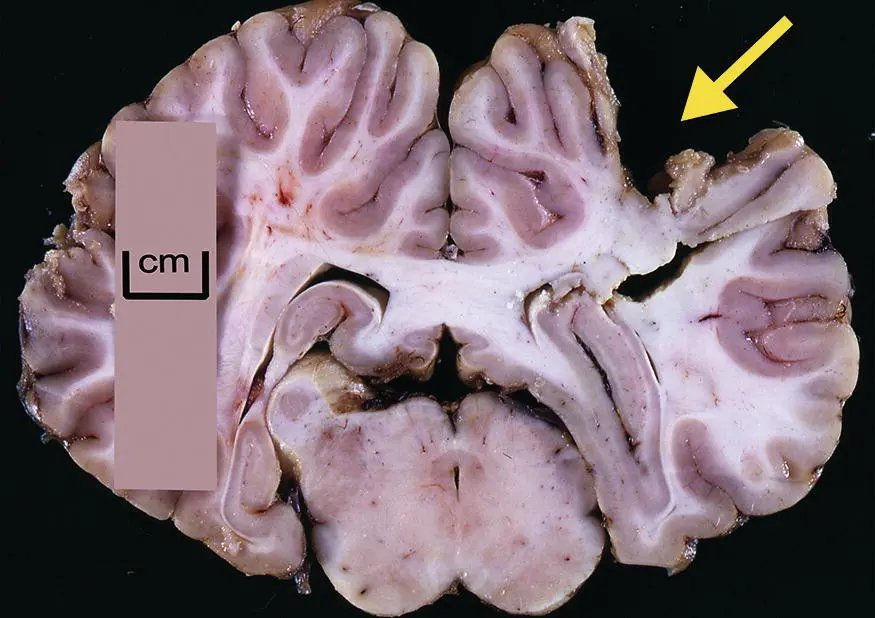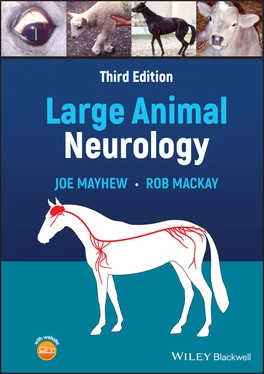Interpretation of findings
Interpretation of signs of brain and cranial nerve disease
Sometimes, quite large chronic forebrain lesions will be present but clinically silent ( Figure 2.5), whereas smaller but acute lesions can often have clinical expression.

Figure 2.5 Large regions of the forebrain of large domestic animals can be regarded as “clinically silent” because when affected by disease processes there may be minimal or no associated clinical signs. Such was the case with a yearling horse whose brain is shown here in section with a defect in the right parietal cerebral cortex that likely resulted from a vascular infarct. At the acute stage of disease, this patient, as a neonate, did demonstrate mild obtundation and wandering in wide circles to the right but made a full clinical recovery within a few days.
The owner or handler will frequently be the best source of information regarding the patient’s behavior, and age, breed, and sex will influence expected response patterns. Occasionally, auditory and tactile stimulation can elicit seizure activity. Focal and mild generalized seizures in neonatal animals may be seen as episodes of repetitive jaw champing, facial twitching, or periods of tachypnea. Bizarre and inappropriate behavior, such as head pressing, compulsive wandering, circling, changes in voice and appetite, and licking objects and aggressiveness, is usually easy to recognize. Other more subtle behavioral abnormalities, such as continual yawning, can be regarded as signs of cerebral disease. An animal with a forebrain lesion that compulsively circles tends to do so toward the side of the lesion.
It is often difficult for a clinician to distinguish between behavioral aberrations associated with organic forebrain disease and compulsive or stereotypic disorders in which no morbid neurologic lesion can usually be identified (see Figure 2.5). Characteristics of behavioral disorders defined as seizures can be mistaken for altered mentation alone such as sleep disorders (see below) and syncope of cardiac origin, and these need to be identified and differentiated. The former two are far more frequently encountered than syncope, although the separation of those two syndromes can be difficult. Other signs of forebrain disease such as an asymmetric menace response, asymmetric sensation perceived from the nasal septum, and asymmetric forelimb hopping all can add to the confidence of a diagnosis of asymmetric forebrain disease resulting in multiple seizures (epilepsy) as opposed to a diagnosis of a sleep disorder. With true narcolepsy in large animals, a prominent degree of cataplexy or loss of all muscle tone is usually seen, and thus recumbency and recovery are most frequently quiet events as opposed to the tonic and clonic situation with epilepsy. Seizures and sleep attacks both tend to occur more often during quiet times, although both may be associated with precipitating factors such as being released into a paddock, feeding, grooming, and other forms of presumably pleasant manipulation. Indeed, strong evidence for focal seizures that do not fully generalize ( i.e ., do not cause recumbency) has been encountered in racehorses during preparation for and after racing. These have tended to involve facial grimacing, followed by head, neck, and even forelimb jerky movements.
An assessment of mental status is made based on the patient’s level of awareness or consciousness that is evidenced by bodily activity seen as a state of arousal. This may well require considerable forebrain functions to be active but requires input from the ascending reticular activating system (ARAS) in the rostral brainstem and thalamus for the state of arousal to be maintained (see Figure 1.7). The level of activity in the ARAS is affected by inputs received by all components of the sensory nervous system, particularly from the special senses of smell, sight and sound, and from noxious inputs. Coma is a state of complete unresponsiveness to noxious stimuli and the deepest comas are usually related to rostral brainstem or particularly thalamic lesions within the ARAS. Semicoma is a state of partial or inappropriate responsiveness to stimuli. Other, less profound, levels of loss of awareness are variously described as stupor, obtundation, somnolence, delirium, lethargy, and inactivity. The term depression is to be avoided in describing suppressed activity in animals because of the subjective connotations it includes in human medicine. Large animals that are recumbent because of spinal cord disease are usually bright and alert unless they are anorectic, dehydrated, exhausted, or unduly frightened.
Prominent changes in behavior and a markedly dampened mental attitude are seen with many forms of forebrain disease, especially those of traumatic, inflammatory, toxic, and metabolic origin. The signs can often fluctuate considerably over minutes to days, and such cases may quickly alternate between a somnolent, unresponsive state to one of hyperexcitability and violent behavior.
Disordered sleep patterns, particularly paroxysmal episodes of sleep as seen with narcolepsy, may require CCTV video monitoring to be seen and to help distinguish from seizures.
Head posture and movement
All normal animals maintain the head in a certain posture and maneuver it quickly and smoothly to perform acts such as prehension of food. Unilateral and asymmetric lesions involving the vestibular system consistently result in a head tilt that is characterized by the poll rotating laterally while the caudal neck and the muzzle remain, or are placed back to, the median plane. In comparison, a horse with a forebrain lesion that tends to turn to one side and to circle, usually, though not always (see Fig 33.1), to the side of the lesion, often has the head and neck deviated toward the direction of the turn. The presence of a head tilt should be evaluated for only when the muzzle and neck are held by the examiner as close to the median plane as possible and rotation of the poll and muzzle can be viewed relative to the median plane. In comparison, with a head turn as seen with forebrain disorders, the long axis of the head usually aligns on the median plane when the muzzle is gently brought back to a median position. A severe vestibular lesion can result in a significant head tilt and head and neck turn, usually both toward the side of the lesion. Animals with bilateral central or peripheral vestibular (and cerebellar) disease frequently show swinging movements of the head and neck, i.e ., head and neck ataxia.
A musculoskeletal disorder, especially involving the neck, must be considered if there is any asymmetry or deviated head and neck posture. Additionally, congenitally blind horses may have abnormal head posture, including a true head tilt, along with jerky head movements, and corresponding eyeball deviations and movements. Such a syndrome may be equivalent to amblyopia in children. In addition, congenital, asymmetric strabismus in horses has been associated with a head tilt with no other evidence of vestibular involvement, and abnormal head posture can be seen in Appaloosa horses with night blindness. Particularly at the onset of a fast gait, many normal horses will hold the head and neck deviated from the median plane: perhaps more related to a reaction to a mouth bit than to speed. Painful conditions such as dental disease, forelimb and hindlimb 14lameness, and caudal cervical arthritis, and asymmetric visual acuity, can also result in abnormal head, neck and trunk positioning during exercise or at rest.
Читать дальше













